Trees with Non-Invasive Roots: Small, Evergreen + Shade Trees
Trees are a perfect addition to any home’s outdoor landscape, but the extensive root systems of most species cause infrastructural damage. Many tree species with non-invasive roots can grow in your yard without worrying about the roots invading your foundation or underground plumbing.
The best trees with non-invasive roots include Adams crabapple, Amur maple, pawpaw fruit tree, American hornbeam, bronze loquat, English holly, Fraser photinia, and the dwarf plum. Some trees are small and suitable for small yards, while others are evergreen shade trees.
10 Trees with Non-invasive Roots
Rather than having to go through the trouble of installing barriers to prevent tree roots from creeping into your foundation, underground plumbing pipes, and sidewalk, it’s easier to simply grow trees with non-invasive roots. Whether you’re looking for an evergreen tree, a fruiting tree, or a shading tree, you can always find a variety with shallow roots at your local tree nursery.
Here are the best trees with non-invasive roots:
Adams Crabapple
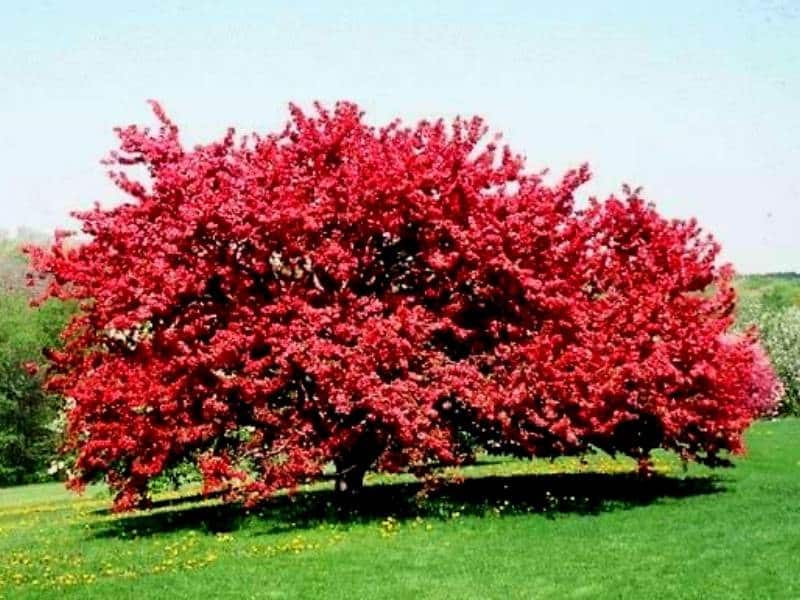
Also known as Malus ‘Adams,’ this vibrant, red-colored tree has non-aggressive roots that mostly lie close to the ground surface even when fully matured.
As such, it’s rare to find the roots of the Adams crabapple invading the home’s foundation or underground plumbing system. This tree species thrives in zones 4-8.
A fully-grown Malus ‘Adams’ tree falls between 15-20 feet in height and grows just as wide. It also produces beautiful pink blossoms in spring, followed by red fruits in fall. This species of crabapple is also notably resistant to a variety of apple diseases like fire blight.
Buy crabapple trees from Fast-Growing-Trees.
Amur Maple
Amur maple grows best in hardiness zones 3-8. It produces colorful red-orange leaves during fall, making it a great ornamental plant.
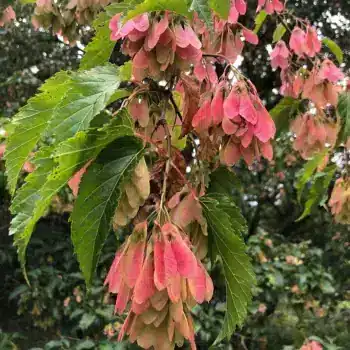
Adult Amur maples are about 30 feet tall and have a lateral spread of about 10 feet, which is wide enough to provide excellent shade.
Due to its shallow and fibrous root system, the roots of this maple species are unlikely to grow into your foundation soil.
Since the Amur maple has moderate drought tolerance, you don’t have to worry about the roots growing into your foundation should you fail to water it for some time.
However, Amur maple is vulnerable to fungal and bacterial diseases like anthracnose and crown gall.
Buy Amur Maple from NatureHills.
English Holly
Scientifically known as Ilex aquifolium, English holly is an evergreen shrub that’s an excellent option for cold-season landscaping. While the taproot of this tree grows deep into the soil, the lateral roots are thinner and non-invasive, as they don’t spread too far out.

English holly thrives in zones 5-8.
English hollies are typically grown together in a row to form beautiful, evergreen hedges along the perimeter of the home’s yard. The white blossoms and bright red fruits add to the shrub’s ornamental appeal.
However, since English holly is dioecious, flowering only occurs in female plants.
Buy English Holly from Fast Growing Trees.
Pawpaw fruit tree
The pawpaw tree is arguably the best option if you want a non-invasive tree whose fruits you can harvest for food.
It produces large yellow and delicious fruits when ripe and can be eaten as is or added to food and smoothie recipes. This plant species is best grown in regions with warm summers and cold winters (zones 5-8).
Pawpaw trees grow to about 20 feet tall and have non-extensive root systems. And even when multiple pawpaw trees are grown close to one another, they tend to graft their roots together, minimizing chances of root invasion to your home’s foundation or sidewalk.
Chinese Pistache
The Chinese pistache produces dense foliage with a height and spread of up to 35 feet at full maturity, making it an excellent shade tree.
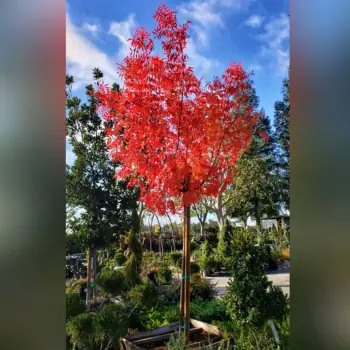
As it’s a drought-tolerant tree, its roots don’t have to spread far away from the root ball in search of moisture. This minimizes the risk of root invasion to your homes foundation and underground piping.
The Chinese pistache thrives in hardiness zones 6-9. It produces red-orange drupes, adding to its ornamental appeal as a landscape plant.
However, as a deciduous tree plant, its leaves tend to fall off during winter, littering the yard.
Get Chinese Pistache from NatureHills.
Bronze Loquat
Botanically known as Eriobotrya deflexa, the Bronze loquat has a shallow, non-invasive root system that doesn’t extend beyond the canopy line.
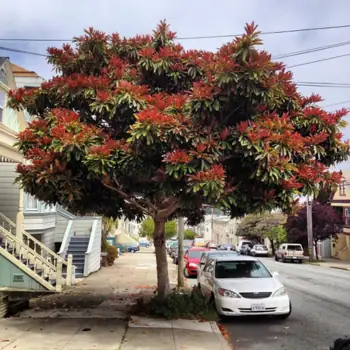
The mature leaves maintain their signature dark green shade throughout the year, while the maroon tinge of emerging foliage adds to the ornamental allure of this tree species.
Bronze loquats are not that tall and grow to a height of 10-15 feet. It’s most commonly used as a patio shade tree but needs to be occasionally pruned to keep the branches from drooping.
This tree species is likely to develop fireblight and root rot problems when grown in wet soil conditions.
Shop Bronze Loquats from Fast Growing Trees.
Citrus trees
Citrus trees typically grow to a height of 18-25 feet tall. They grow well in hardiness zones 9-11. This genus of flowering plants produces pulpy fruits with a sweet taste. The roots of citrus trees typically grow to match the canopy drip line of the tree, which is usually about eight feet tall.
Moreover, more than three-quarters of the tree’s root system is usually clumped up within the first two feet of the root ball, reducing the chances of root invasion.

Some citrus tree options that can be planted near houses without risking damage to foundations and pipes include:
- Meyer Lemon – It has a compact root system and typically only spreads about 3-5 feet from the trunk.
- Bearss Lime – A seedless Persian lime variety that’s small (about 10 feet tall at maturity. Its roots are not overly aggressive.
- Kaffir Lime – The Kaffir lime is a shrubby tree with a compact root system focused more vertically than outward. See more varieties of lime trees here.
- Calamondin – Also called calamansi, this dwarf citrus has very compact, non-invasive roots and only reaches about 3-4 feet tall.
- Blood orange – Most orange varieties remain fairly compact and have shallow, non-destructive roots.
- Satsuma Mandarin – Smaller mandarin varieties like Satsuma tend to have slower-growing, less invasive roots.
- Kumquat – These tiny citrus trees have small root systems and only grow 8-15 feet tall.
Choose dwarf, shrubby, or bush-like citrus varieties. Still, I recommend planting them far enough from foundations, walls, and pipes as a precaution.
Gardener’s note: Watering citrus trees regularly is of absolute importance, otherwise, the roots may grow as wide as 40 feet in search of moisture and invade your home’s foundation if you don’t keep the tree well-watered.
American Hornbeam
If you’re looking for a permanent backyard/front yard tree, the American Hornbeam, which can live for up to 300 years, may be your best option.
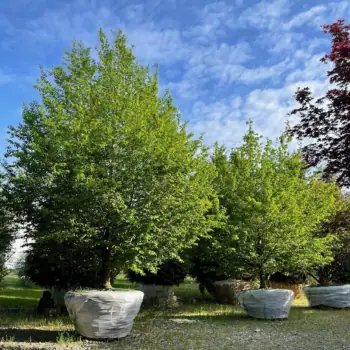
Grown in USDA hardiness zones 3-9, this fruit tree typically grows up to 30 feet tall. The American hornbeam has a low potential to cause infrastructural damage, as root growth is non-aggressive.
You can also train it into a bonsai.
The American hornbeam’s shiny, dark green leaves add a touch of natural beauty to any landscape. During fall, the leaves turn to shades of red and yellow, making it even more visually appealing.
One downside to this tree species is that it’s a slow grower.
Buy American Hornbeam from NatureHills.
Fraser Photinia
Also known as Red tip photinia, Fraser photinia is a small, evergreen tree/shrub that can grow up to 10 feet tall at full maturity. The tree’s roots grow close to the ground surface and are not aggressive. Fraser photinia thrives in hardiness zones 7-9.
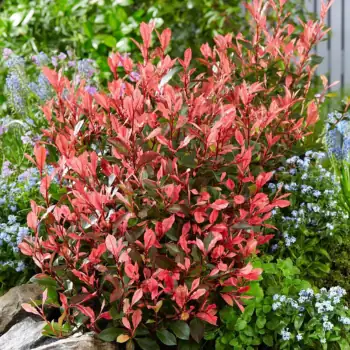
During spring and mid-summer, new leaves emerge and are vibrant red in color, making this shrub a great ornamental plant.
Meanwhile, the mature leaves will stay green throughout the cold season, making it an excellent choice for winter landscaping. However, Fraser photinia is highly susceptible to leaf spot disease.
Where to get Fraser photinia: Fast Growing Trees.
Dwarf Plum Tree
As the name suggests, the dwarf plum tree is a short tree species that grows to a height of 5-7 feet at full maturity.
This tree is great for homeowners with limited garden/yard space, as they take up minimal space and have small, non-extensive root systems compared to regular plums.
These plums are great fruits that thrive in zones 4 all the way to 9.

The dwarf plum tree’s low height makes maintenance easy, as you can prune it from the safety of the ground.
Some dwarf or semi-dwarf plum varieties with non-destructive roots include Shiro and Satsuma.
Plum trees yield oblong plum fruits that you can use to make fruit jam or add to your food recipes.
On the downside, this type of tree will likely suffer drought damage if grown too close to other trees with deeper, more extensive root systems.
Buy Dwarf Plum Trees from NatureHills.
List of Shade Trees with Non-invasive roots
Shade trees make the backyard a great relaxing place, as they filter the sun’s harsh rays. You can even install a hammock between two shade trees and enjoy your afternoons in your yard.
Here’s a list of the best shade trees with non-aggressive roots.
- Trident maple
- Amur maple
- Florida maple
- Fraser photinia
- Chinese pistache
- Blue-Beech tree
List of Fruit Trees with Non-invasive Roots
For many gardening enthusiasts, there’s no greater satisfaction than sourcing food from one’s own garden. With fruit trees, you can harvest fresh fruits every season.
Here’s a list of the best fruit trees with non-invasive root systems:
- Miniature cherry
- European cornel
- Miniature apricot
- Pawpaw tree
- Miniature orange
- Citrus trees
- Miniature plum
- Adams crabapple
- Miniature plum tree
- Kousa dogwood tree
Evergreen Trees
If you prefer trees whose leaves remain lush green through more than one growing season, go for an evergreen tree. These tree varieties will retain the color of their foliage even during cold winter.
Here’s a list of evergreen trees with non-invasive root systems:
- English holly
- Red tip photinia
- Hollywood juniper
- Skyrocket juniper
- Bronze loquat
- Australian willow
- Olive tree
Can roots damage foundations and pipes?
Invasive roots are sometimes the main cause of cracks in concrete foundations. These roots typically grow laterally and closer to the soil surface, where moisture, oxygen, and nutrients are abundant.
However, since porous concrete slab foundations have a lot of moisture below them, some roots may grow downwards to reach this moisture.
As the roots drain away moisture from the foundation soil, soil pressure drastically reduces, causing the foundation to crack. To prevent and minimize this kind of damage, try growing fruit, shade, and privacy trees with non-invasive roots.
Remember that invasive tree roots aren’t always the primary cause of foundation damage and may simply exacerbate existing structural damage to your foundation. Tree roots typically grow along the path of least resistance.
Therefore, if pre-existing cracks within your foundation are caused by shrinking, small roots will grow downwards toward the foundation cracks.
Meanwhile, if you have any leaks within your plumbing pipes due to wear, tree roots may penetrate the pipes and block your water and sewerage systems. It costs lots of time and money to unclog underground plumbing pipes blocked by invasive tree roots. As such, you should always grow trees as far away as possible from your plumbing systems.
FAQ
What trees can be planted close to a house?
Small ornamental trees like Japanese maples, dogwoods, redbuds, and crabapples generally have small root systems that won’t damage foundations. They can be planted close to a house, but we recommend at least 15-20 feet between them and the foundations.
Which trees have roots that grow straight down?
Species like oak, elm, and black walnut have a taproot system that grows straight down with few lateral roots. This makes them less likely to interfere with sidewalks, sewers, and foundation walls than trees with spreading roots.
Which maple trees have non-invasive roots?
Some maples like the Amur, tatarian, and Japanese maple have a more compact root system that tends to grow downward rather than outward. They are suitable for planting near patios and walkways while keeping a safe distance of at least 15 feet away from foundations.
What trees are safe for foundations?
Trees less likely to damage foundations include columnar apples, alders, arborvitae, Japanese zelkova, and many upright juniper varieties. Plant them at least 10 feet away from foundations and walls. Monitor for invasive surface roots over time.
References
- Lindsey Purcell, Urban Forestry Specialist; Purdue University, Department of Forestry and Natural Resources: Can tree roots cause damage to a home’s foundation?
- Sherry Rindels, Department of Horticulture; Iowa State University Extension: Tree Root Systems
- Sharon Morrisey, Consumer Horticulture Agent, Milwaukee County UW-Extension: Our Most Common Trees and Shrubs and their problems


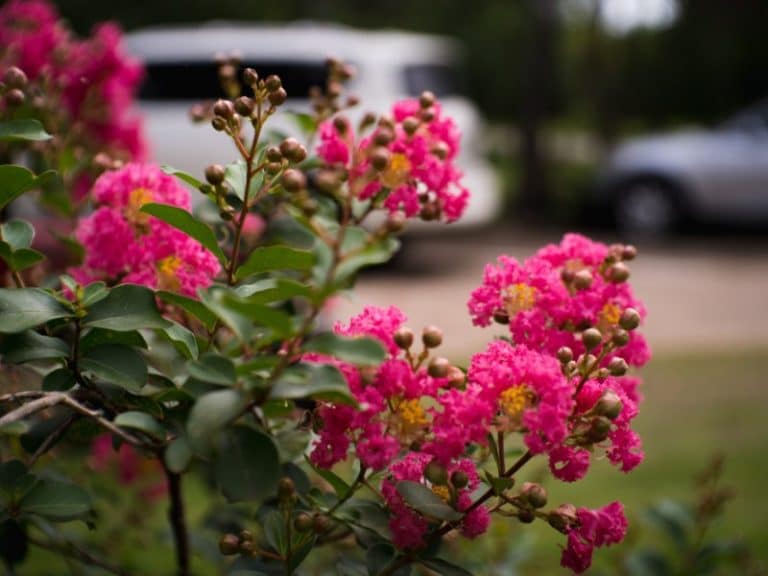


Thank you very much for this information. Yours is the first article I’ve encountered that answers my question with enough detail about each tree to aid my decision.